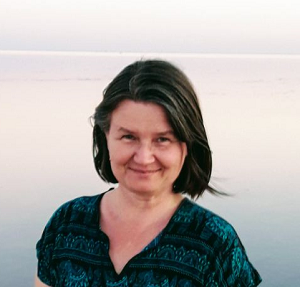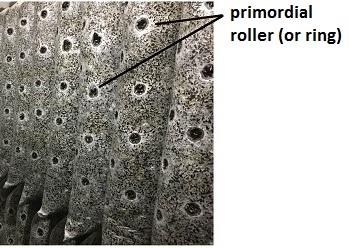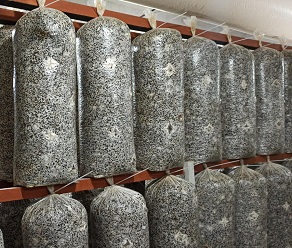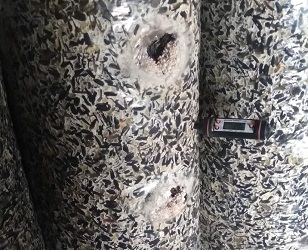
It seems that this is a topic for beginners, but I advise everyone to read: maybe you will find new information.
Table of Contents:
Primordia are the very first stage of formation of fungal fruiting bodies.
When the mycelium is completely overgrown in the substrate, its hyphae begin to condense near the slits, first forming a dense white mass, which then transforms into oyster mushroom rudiments, which we call "primordia".
Primordia is formed when the substrate is completely overgrown.
First, a white hyphal condensation (small ridge) appears around the opening of the mushroom blocks. This indicates that the mushroom pins will appear in a day or two.
That is, the compaction of mycelial hyphae, from which the primordium then grows. These are the first signs of mushroom pinning.
This is another name for the primordial ridge. This is exactly what they look like - like a dense white formation near the film cuts.
On round holes, hyphal knots is very clearly visible (photo on the left).
On holes of a different shape, it can be just a white mass, quite dense, well overgrown (right).


If you have a single-zone system, start gradually changing the climate to growing conditions at the primordial ring stage.
If you have a two-zone system, take the batch out of the incubator when one or two pins appear on several blocks, they are called signal primordia.
If you maintain the optimal temperature for block overgrowth, two to three days pass from the appearance of hyphal knots to the formation of primordia (pinning stage).
If the room temperature is below 17 degrees Celsius, pins form more slowly, you may see them on the 5th or 6th day.
If we are talking about golden or pink oyster mushroom or other heat-loving strains, pins may not form at low temperatures, although hyphal knots will be clearly distinguishable.
In different countries, the appearance of white fluff from the slot and the further development of the oyster mushroom fruiting bodies are called by different words. That is, there is no single concept and name for the stages of oyster mushroom development.
Below I will describe the sequence of origin and development of fruiting bodies, with a description of their appearance and call them by the words that are accepted in our country.
 At first, primordials look like foam with barely visible dots - some people say “semolina”. The next stage is the appearance of small individual white balls - this is the “pin stage”.
At first, primordials look like foam with barely visible dots - some people say “semolina”. The next stage is the appearance of small individual white balls - this is the “pin stage”.
The gray or gray-brown shade of growing mushrooms appears a little later, about a day later.
Below there are 4 photos where the same slot is photographed at different stages - from hyphal knots to a well-developed cluster of oyster mushrooms.
Mushroom pins are the beginnings of mushrooms.
And here we see a little confusion in the use of terms.
In some countries, primordia are called the rudiments of fungi from the moment of their appearance until the moment of division into individual mushrooms with a color characteristic of a given strain. There mushroom growers don’t use the word pins at all.
In some countries it’s exactly the opposite - all of the above are called pins and they don’t even know what primordia are.
There is also an intermediate option, which I describe in this article.
That is, the primordium is the white mushroom tissue that is formed from the hyphal knots, and the pins are the stage when the mushrooms have already divided and they really look like the pins that tailors use.
In my country, everything that is depicted in the four photos that you see below is called in one word - primordia. And when the mushrooms become larger, this clump is called a “cluster” or “druze”.
From the time such primordia appear as in the photo below on the left until the formation of such pins as in the photo on the right, it takes from 24 to 36 hours.
This time depends on the conditions in which the primordia grow.
With the single-zone growing method, where you slowly lower the temperature to allow the mycelium to begin fruiting, the primordia grow faster. It is very important to maintain optimal humidity at this moment.
Look at these four photos and note the date they were taken.
 hyphal knots
hyphal knots Primordium stage
Primordium stage

The photo on the left shows the division into individual mushrooms (oyster mushroom pins) and it is in this state that they must be transferred.
If the blocks are moved later - in the form as in the next photo - some of the mushrooms may die due to condensate.


Will condensate settle on the primordia or not - depends on the conditions in your chamber.
If the chamber is 12-13 degrees, and in the incubator 20-21C, in addition, the humidity in the chamber is 10-12% higher than in the incubator - the condensate is deposited on small caps and they suffocate.
The color is related to the strain. If the brown color of the oyster mushroom cap is characteristic of the strain, the pins are practically never white - they immediately come out of the slot in cream shades.
In strains of the K and P lines, they are white for the first day, then gray.
When it's cold, they are so dark that they appear black. Lighten to dark gray as they grow.
The color should be uniform.
Any plaque, scales or growths mean a violation of the microclimate in the later stages of incubation or a sharp change in conditions when transferred from the incubator to the growing room.
The timing of the appearance of primordia depends on two reasons:
